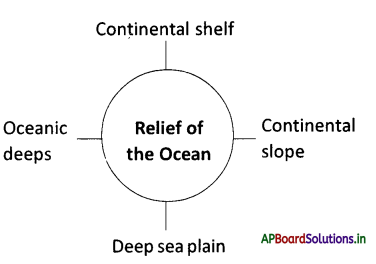Students can go through AP State Board 9th Class Social Studies Notes Chapter 3 Hydrosphere to understand and remember the concept easily.
AP State Board Syllabus 9th Class Social Studies Notes Chapter 3 Hydrosphere
→ From all sources of water reaching the earth less than 1 % of water is useful to man.
→ The cyclic process in which water undergoing a cycle from oceans to land and land to oceans is called the hydrological cycle.
→ There are six stages of the water cycle. They are
- Evaporation
- Transportation
- Condensation
- Precipitation
- Runoff and
- Groundwater.
→ Of the total water on the earth, 97.25% is saline ocean waters and 2.75% is freshwater.
→ Continents and oceans are the first-order relief features of the earth.
→ There are five oceans on the earth. They are
- The Pacific Ocean
- The Atlantic Ocean
- The Indian Ocean
- The Southern Ocean and
- The Arctic Ocean.
→ Millions of years ago oceans were combined together. The single super ocean was known as Panthalassa.
→ Continental shelf, Continental slope, Deep sea plain, and Oceanic deeps or Trenches are the reliefs of the ocean.
→ Most of the deepest trenches are located close to the continents.
→ A line joining points on the sea bed at an equal vertical distance beneath the surface is called ‘Isobath’or ‘Depth contour’.
→ Over millions of years rain, rivers and streams have washed over rocks containing the compound Sodium Chloride (NaCl) and carried them into the sea.
→ The total content of dissolved salts in seawater is called salinity.
→ Salinity is usually expressed as parts per thousand or ppt.
![]()
→ The average salinity of the oceans is 35%0 or about 35 parts of salt in 1000 parts of water.
→ A line joining the points in the ocean that has the same degree of salinity is called ‘Isohaline’.
→ The ocean temperature is influenced by latitudes, winds and ocean currents, unequal distribution of land, and change of seasons.
→ As one goes deep inside the oceans, the temperature rapidly decreases for every 1 km and remains stable at the foot of the ocean.
→ Generally, warm currents flow towards the poles and cold currents flow towards the Equator.
→ The ocean current which flows speedily is called a stream and that which flows slowly is called a drift
→ Centrifugal force, effects of winds, the effect of precipitation, and the effect of solar energy are the causes for the ocean currents.
→ Stream: The ocean current that flows speedily is called a stream.
→ Drift: The ocean current that flows slowly is called a drift.
→ Ocean current: The general movement of a mass of water in a fairly defined direction over a great distance.
→ Transpiration: A considerable proportion of water vapor is released into the atmosphere by plants, through a process called ‘Transpiration’.
→ Salinity: The total content of dissolved salts in seawater is called salinity.
→ Elnino; Lanino: These are the effects caused by the changes in temperature in the Pacific Ocean.
→ Centrifugal force: The radially outward force on a body in a uniform circular motion, observable only in a rotating frame of reference is called ‘Centrifugal force’.
→ Hydrological cycle: Water undergoes a cycle from oceans to land and then from land to the oceans. This cyclic process is called the hydrological cycle.
→ Evaporation: The process by which water changes from a liquid to a gas is called evaporation.
→ Condensation: Forming tiny droplets and clouds from water vapor is called condensation.
![]()
→ Precipitation: Transporting water from the atmosphere in the form of rain, sleet or snow, is called precipitation.
→ Sea: A sea is a body of saline water partly or fully enclosed by land.
→ Continental shelf: The border zone between land and sea with depth up to 200 m is called the continental shelf.
→ Continental slope: The complex relief of the ocean spread from 200 m to 3000 m is called the continental slope.
→ Deep-sea plain: Gently sloping areas of the ocean basins whose depths vary between 3000 m to 6000 m are called deep-sea plains.
→ Oceanic Deeps (or) Trenches: The large narrow trenches that plunge as great ocean deeps to a depth of 6000 m are called oceanic depths or trenches.
→ Isoline: A-line joining the points in the ocean having the same degree of salinity is called Isohaline.


→ Millions of years ago, oceans were combined together. The single super ocean was known as ‘Panthalsa’.
→ Isobaths: A-line joining points on the sea bed at an equal vertical distance beneath the surface. Sometimes referred to as depth contours.
→ River water contains 2% of sodium chloride.
→ Highest Salinity in Water bodies
- Lake Van – Turkey – 330%
- Dead Sea – Israel – 238%
- Great Salt lake – the USA – 220%
→ Lowest Salinity in Water bodies
- Baltic Sea – 3-15%
- Hudson Bay – 3-15%
→ The highest temperature is recorded in the Inland Seas. The temperature is the highest in the Red Sea, i.e., 38°C.
→ Access to Pure Water
| 68.7% | Ice and snow |
| 29.9% | Underground water |
| 1.4% | Rivers, lakes, and reservoirs |
| 100.0% | Total |